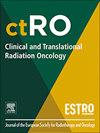Real-world outcomes of prophylactic cranial irradiation utilization and efficacy for patients with extensive-stage small cell lung cancer treated with consolidative thoracic radiotherapy
IF 2.7
3区 医学
Q3 ONCOLOGY
引用次数: 0
Abstract
Background
The role of prophylactic cranial irradiation (PCI) is not well-defined in extensive-stage SCLC (ES-SCLC), with conflicting results from randomized trials and a lack of relevant data for patients who received consolidative thoracic radiotherapy (CTRT). We sought to evaluate the impact of PCI on the outcomes of ES-SCLC patients who were all treated with CTRT.
Methods
A retrospective analysis of ES-SCLC patients without brain metastases who were all treated with CTRT between 2013–2021 at our institution was conducted. Overall survival (OS) and incidence of brain failure (BFR) were estimated using Kaplan-Meier estimation and cumulative incidence function. Multivariable Cox or Fine-Gray’s proportional hazard regression analysis (MVA) were performed to determine association between PCI and OS.
Results
47 patients met inclusion criteria and were theoretically eligible for PCI, 27 (57.4 %) received PCI and CTRT while 20 (42.6 %) received CTRT alone. Baseline characteristics were similar except for age, where patients receiving PCI were younger (median age 62) compared to patients who did not receive PCI (median age 72). Median OS with PCI was 19.2 months, compared to 10.8 months without PCI (P = 0.0334). This improved OS remained apparent in patients who received post-chemotherapy MRI restaging (P = 0.0245). BFR was reduced with PCI (HR = 0.22 [0.09–0.52], P = 0.0004). On MVA, PCI was significantly and independently associated with improved OS (HR = 0.39 [0.19–0.80], P = 0.01) and reduced BFR (HR = 0.20 [0.09–0.44], P = < 0.001).
Conclusion
This real-world study found PCI was independently associated with improved OS and reduced BFR in ES-SCLC patients treated with CTRT compared to patients treated with CTRT not receiving PCI, including after post-chemotherapy brain MRI. The role of PCI with CTRT should be evaluated in prospective studies.
广泛期小细胞肺癌胸部巩固放疗患者预防性颅脑照射的实际结果和疗效。
背景:预防性颅脑照射(PCI)在大分期SCLC (ES-SCLC)中的作用尚未明确,随机试验的结果相互矛盾,并且缺乏接受胸部巩固放疗(CTRT)患者的相关数据。我们试图评估PCI对所有接受CTRT治疗的ES-SCLC患者预后的影响。方法:回顾性分析我院2013-2021年间接受CTRT治疗的ES-SCLC无脑转移患者。采用Kaplan-Meier估计和累积发生率函数估计总生存期(OS)和脑衰竭发生率(BFR)。采用多变量Cox或Fine-Gray比例风险回归分析(MVA)确定PCI与OS的相关性。结果:47例患者符合纳入标准,理论上符合PCI, 27例(57.4%)接受PCI + CTRT, 20例(42.6%)单独接受CTRT。基线特征相似,除了年龄,接受PCI的患者比未接受PCI的患者更年轻(中位年龄62岁)(中位年龄72岁)。PCI组的中位OS为19.2个月,而非PCI组的中位OS为10.8个月(P = 0.0334)。在接受化疗后MRI再分期的患者中,OS的改善仍然明显(P = 0.0245)。PCI组BFR降低(HR = 0.22 [0.09-0.52], P = 0.0004)。在MVA中,PCI与改善OS (HR = 0.39 [0.19-0.80], P = 0.01)和降低BFR (HR = 0.20 [0.09-0.44], P = < 0.001)显著独立相关。结论:这项现实世界的研究发现,与接受CTRT治疗的未接受PCI治疗的患者相比,接受CTRT治疗的ES-SCLC患者的OS改善和BFR降低独立相关,包括化疗后脑MRI。PCI与CTRT的作用应在前瞻性研究中进行评估。
本文章由计算机程序翻译,如有差异,请以英文原文为准。
求助全文
约1分钟内获得全文
求助全文
来源期刊

Clinical and Translational Radiation Oncology
Medicine-Radiology, Nuclear Medicine and Imaging
CiteScore
5.30
自引率
3.20%
发文量
114
审稿时长
40 days
 求助内容:
求助内容: 应助结果提醒方式:
应助结果提醒方式:


